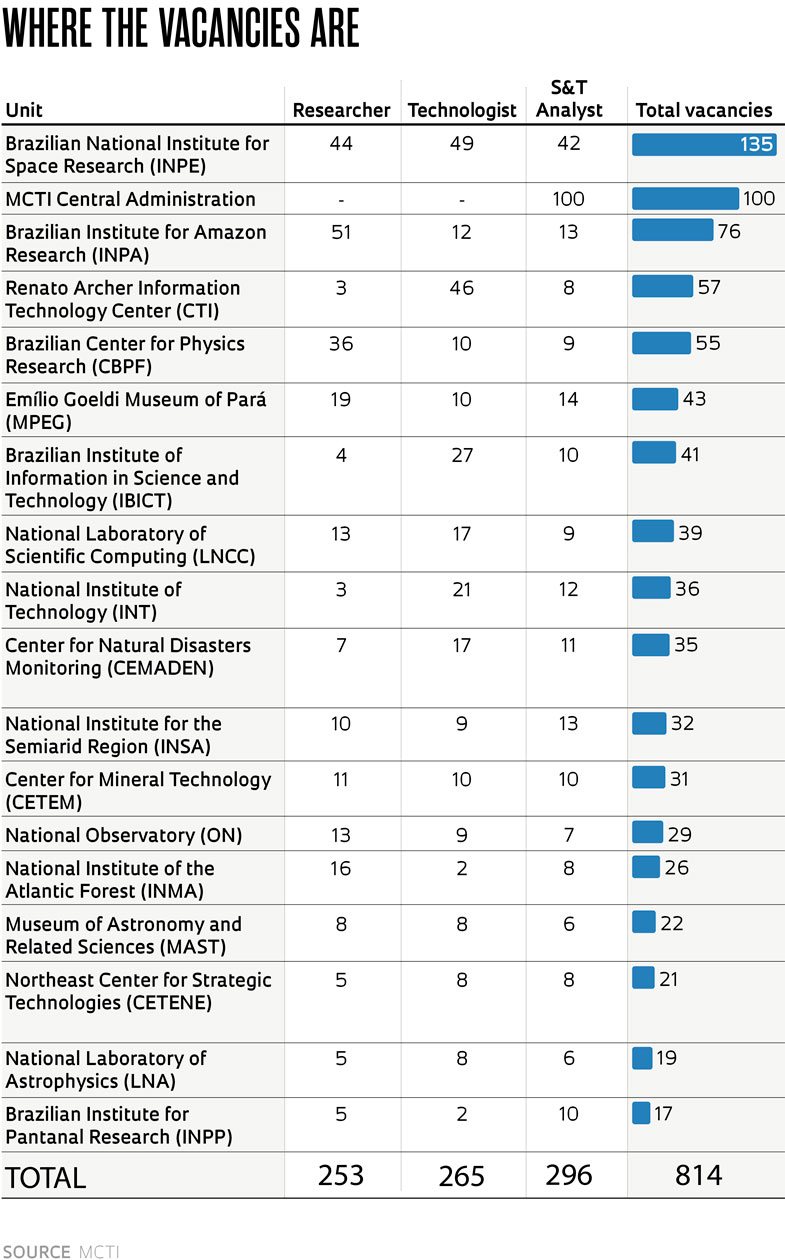 smolaw11 / Getty Images
smolaw11 / Getty ImagesThe recent announcement of competitive examinations to fill 814 positions within the Ministry of Science, Technology, and Innovation (MCTI) and 17 affiliated research institutions has brought a sigh of relief to institution managers and the broader scientific community. But while acknowledging the government’s efforts to address understaffing at federal research institutions by initiating recruitment within the first year of its term, institution managers say the number of new hires is far less than ideal. Although the new vacancies represent a 35% increase over the current 2,354 active employees, they are unlikely to fully replenish the staff lost to retirements, deaths, or resignations after over a decade with no new recruitment. Applications for available vacancies will be accepted in most institutions until early December.
The Brazilian National Institute for Space Research (INPE), which has the highest number of available positions (135 in total), would require 400 new hires solely to fill positions classified as “maximum priority,” according to Oswaldo Duarte Miranda, an aide to the institution’s director. “At present, we have 667 employees with an average age of 55, including 190 who have agreed to remain in exchange for retention bonuses and could retire at any moment. Ten years ago, INPE had 1,005 employees,” he says. A retention bonus is a benefit, equivalent to an employee’s pension contribution, that is awarded to those who decide to continue in active service after becoming eligible for retirement. “The new hires will provide some relief but we will still fall short of the optimal 1,200 employees.”
Several research lines and activities at INPE have been hampered by understaffing. One example is a project established in 1985 to map fire hotspots in Brazil. In addition to the challenges stemming from years of reduced staffing, the project recently suffered a setback with the loss of one of its key researchers, Alberto Setzer, who passed away at the age of 72 in September (see Pesquisa FAPESP issue nº 332). “We have many researchers with over 40 years of service at INPE who have a wealth of knowledge to impart to newcomers. The vacancies that have been opened offer a tremendous opportunity for young researchers,” says Miranda, who is a researcher in the astrophysics division at INPE and himself has 19 years of service.
Out of the total of 814 newly opened vacancies, 100 are at the Central Administration of the MCTI, equally divided among five departments. The remaining 714 positions are distributed across 16 research units affiliated with the MCTI—among them INPE. Vacancies have been opened for 253 new researchers, 265 technologists (with a focus on research applications), and 196 science & technology analysts (working in administrative roles).
Each unit is responsible for defining its own recruiting rules and organizing its selection process, including the formation of expert panels for candidate assessment. As a general rule, only research positions require a doctoral degree. According to the MCTI’s salary table for positions requiring higher-education degrees, monthly salaries range from R$6,662.68 to R$19,586.95 depending on the class (junior, middle I, middle II, middle III, and senior) and type of degree (undergraduate, specialization, master’s, and PhD).
Research units have sought external support to organize competitive examinations, which will take place early next year. INPE, for example, has engaged the Getulio Vargas Foundation (FGV). Many units have already published their examination notices, coordinating among themselves to avoid coinciding dates. Vacancies for analysts will not require expert panel evaluations, with selections determined through a unified examination organized by the Ministry of Management and Innovation in Public Services (MGI).
An opportunity for grant beneficiaries
The Renato Archer Information Technology Center (CTI) in Campinas (SP) has announced a competitive examination to fill positions primarily for technologists—a total of 46 technologist vacancies have been announced. Another eight openings are offered for analysts and three for researchers. The higher number of technologist positions reflects the institution’s emphasis on applied research in areas such as microelectronics, 3D printing, and artificial intelligence. The center is currently staffed by 83 employees, but these are supplemented by 75 grant beneficiaries who perform technical supporting roles within projects. Many of these grant beneficiaries are now preparing to apply for the positions being offered.
“Given that many candidates are already working at CTI, we have decided that the evaluation panels in the second phase of the selection process will mostly be professors and researchers from outside the CTI. We will bring in specialists with the necessary expertise for each position,” says CTI director Jorge Vicente Lopes da Silva, who celebrated 35 years of service at the institution last year. The roles offered align with the CTI’s master plan, which establishes focus areas such as Industry 4.0, advanced life sciences, enabling technologies, and digital government. One of the research areas that has not progressed at the desired pace due to a shortage of personnel is bio-based manufacturing. With the new hires, this research department will now have up to five additional professionals, significantly expanding its current staff.
The Brazilian Center for Physics Research (CBPF) is offering a higher proportion of researcher vacancies—36 compared to 10 technologists and 9 analysts. These positions will nearly double the number of university-level staff, which currently stands at 58 professionals—43 researchers, 12 technologists, and three analysts, who are supported by 33 secondary-level employees and 102 outsourced personnel.
“The institution has previously had a roster of as many as 120 researchers. Although the newly announced hires are certainly important, we will continue to be understaffed compared to previous levels. We will, however, be at the level we were at early in the last decade,” says deputy director João Paulo Sinnecker. CBPF will soon be faced with additional departures. The average age of the 44 active researchers is 58.7 years, with 15 of them already eligible for retention bonus. Of these, 10 will reach the compulsory retirement age of 75 within the next three years.
Sinnecker believes staff replenishment is necessary, but a more gradual approach over the past few years would have been more suitable than a single recruiting program to make up for the cumulative deficit. “We would have preferred these individuals to arrive gradually, perhaps over a period of three years, to allow them to assimilate into our culture.” He anticipates a “generation shock” and underscores the importance of familiarizing new employees with CBPF’s mission and the unique aspects of working as a researcher in an MCTI unit.
The team’s high caliber has enabled it to meet the targets agreed upon with the MCTI despite the gradual reduction in staff. The volume of publications has remained consistent at around 400 per year.
Various factors were considered in defining the job profiles announced at CBPF. The evaluation panel is composed of two representatives from each department, one more senior and one younger, in order to capture perspectives across generations. The majority of the new positions will be in experimental physics, with ongoing research areas including condensed matter, observational cosmology, and nanoscience. The center has also decided to initiate research in a new domain, quantum optics, with four researcher positions dedicated to developing devices for building quantum computing chips.
At the National Laboratory of Scientific Computing (LNCC) in Petrópolis (RJ), 39 new hires will double the team’s size. With a current staff of 60 members (including 10 individuals drawn from elsewhere to join LNCC), approximately one-third of the team is either already eligible for retirement or will be within the next three years. Even with these new hires, the team will only be half as strong as it was in the early 1990s, when it had 137 members.
“The consequence of this is that we are unable to fully fulfill our mission, even with our team’s recognized capabilities,” laments Fábio Borges de Oliveira, a mathematician and director at LNCC. He anticipates a decline in the center’s performance metrics in the coming years, such as the number of publications per researcher. His projection is based on the expected retirement of several experienced and highly productive LNCC researchers, including Marcelo Dutra Fragoso, Carlos Emanuel de Souza, and Renato Portugal. These were ranked among Brazil’s most influential or widely cited researchers globally in the 2023 edition of a list compiled at Stanford University, utilizing data from Scopus, an abstract and citation database.
Hiring autonomy
According to Nilson Gabas Jr., director of the Emílio Goeldi Museum of Pará, the addition of 43 new staff members will provide a valuable boost to help meet the institution’s growing demand, but will still fall considerably short of the number it needs. There are presently 168 active employees, and approximately 50 of them are either already eligible for retention bonus or will be eligible for retirement within the next three years. The new hires will only partly offset the anticipated departures.
“The Amazon is currently experiencing a boom in scientific interest, and our institution is at the epicenter,” notes Gabas Jr. The museum’s home city of Belém, Pará, is set to host COP30—the 30th edition of the United Nations Climate Conference—in 2025. “We have the potential to play a more active role in various initiatives and programs, but in order to do so and establish ourselves as the institution of reference in the region, we would need a significantly larger team.”
The museum managers hope that the federal government, recognizing that staffing levels remain dire, will launch an additional round of hires by 2026. One potential solution would be to grant research units the authority to automatically fill vacancies resulting from retirements, deaths, or resignations. “Federal universities already have this autonomy; deans can organize periodic recruiting rounds for the purpose of filling vacancies. We believe it is fair, necessary, and urgent for research units to be granted the same privilege,” says Gabas Jr., who is among the leading advocates of this idea, alongside other directors of institutions affiliated with the MCTI. However, granting hiring autonomy would require a regulatory reform. Federal universities operate as independent organizations under the oversight of the Ministry of Education, while research units affiliated with MCTI are directly part of the Federal Government. Under current legislation, government authorization is required for organizing recruiting programs such as the one currently underway.
Republish smolaw11 / Getty Images
smolaw11 / Getty Images
